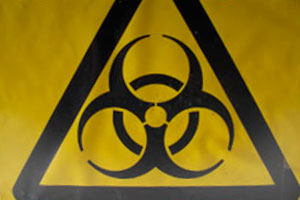
Hazardous Waste Warning
Wastes in this section are dangerous to you and the environment. Handle them carefully and dispose of them properly. Legally, households may not transport more than 15 gallons of wet or 125 pounds of dry hazardous materials. Read about the regulation.
Treated Wood
Treated wood, commonly used in fence posts, decking, and landscaping projects, contains chemicals to protect the wood from insects and fungal decay. Among these chemicals are arsenic, chromium, copper, and creosote. While they do a great job preserving the wood, the chemicals are anything but great if they end up in our environment. The facilities listed below will properly manage your treated wood waste (TWW).
TWW can be taken to all of the locations listed at the bottom of this page. No variance or permit is required for disposal.
Please keep any TWW separated from other materials when you bring it for disposal. If other materials are combined with TWW, you will need to pay the TWW fee for the entire load.
Click here for more information on treated wood from the Department of Toxic Substances Control. This webpage gives useful tips on how to handle TWW at home and for your business.
Call us at (805) 882-3603 if you have more questions.
A note on TWW legislative updates:
2021 was a big year for TWW. Prior to January 1, 2021, TWW was a hazardous waste that had a special set of disposal standards called the Alternative Management Standards (AMS). These standards recognized that TWW was hazardous, but when contained properly in a landfill there was very little environmental impact, if any at all. AMS rules allowed local landfills to accept TWW and avoid the costs and risks of over handling and transporting the material.
Unfortunately the AMS were buried in a separate bill, SB 68. SB 68 was vetoed in late 2020 for other reasons, meaning that starting January 1, 2021 TWW needed to be handled as a hazardous waste with no special treatment, and only one landfill in California accepted the material.The Department Substances Control quickly created a variance program for local disposal facilities, but obtaining this permit was very costly to generators, handlers, and disposal facilities.
AB 332 was written in early 2021 to bring the AMS back. The County of Santa Barbara and other local jurisdictions authored advocacy letters to support AB 332. Thankfully, AB 332 passed on August 31, 2021 which reinstated the Alternative Management Standards. AB 332 provided a huge relief to contractors, waste haulers, residents, and local governments.
Where to go
-
Santa Barbara Area (1)
- *South Coast Recycling and Transfer Station — 4430 Calle Real
-
Goleta & UCSB Area (1)
- *South Coast Recycling & Transfer Station — 4430 Calle Real
-
Santa Ynez Valley (1)
- *Santa Ynez Valley Recycling and Transfer Station — 4004 Foxen Canyon Road
-
Lompoc Valley & VAFB (1)
- City of Lompoc Landfill (Scalehouse) — Avalon Rd (south end)
-
Santa Maria Valley (1)
- City of Santa Maria Landfill, aka City of Santa Maria Regional Landfill — 2065 East Main Street
-
Cuyama Valley (2)
- *New Cuyama Transfer Station — 5073 Highway 166
- *Ventucopa Transfer Station — Highway 33
-
Outside Santa Barbara County (5)
- Buttonwillow Landfill Facility — 2500 W. Lokern Road
- International Disposal Corp. of California (Newby Island) — 1601 Dixon Landing Rd. Milpitas, CA 94306
- Keller Canyon Landfill — 901 Bailey Road, Pittsburg, Ca. 94565
- Kettleman Hills Landfill Facility — 35251 Old Skyline Road
- Vasco Road Landfill — 4001 North Vasco Road, Livermore Ca. 94551
Related Materials
- Agricultural Waste Recycling
- Treated Wood
- Hazardous Waste Regulation
- Untreated Wood & Pallets Recycling
Related Articles
-
Holiday Facility Closures
December 20, 2023 by Tori Kampmann - Hazardous Waste Recycling/Disposal -
America Recycles Day November 15th
November 08, 2019 by Leslie Robinson - Recycle -
Latest Annual Report Available for County’s Hazardous Waste Collection Program
January 10, 2024 by Tori Kampmann - Hazardous Waste Recycling/Disposal -
Thomas Fire Clean-Up Tips & Guidelines
-
Thanksgiving Facility Closures
November 22, 2023 by Tori Kampmann - Hazardous Waste Recycling/Disposal -
RRWM’s Annual Waste Management Report Now Available
October 05, 2017 by Alan Nakashima - Recycle -
Easy Battery Recycling at Curbside
May 31, 2019 by Jody Rundle - Hazardous Waste Recycling/Disposal -
Battery Recycling Made Easy
November 30, 2015 by Jody Rundle - Hazardous Waste Recycling/Disposal -
Free Hazardous Waste Events October 5 & 6
September 30, 2019 by Leslie Robinson -
Reminder: Santa Ynez Valley Hazardous Waste Collection Event Postponed
March 23, 2020 by Leslie Robinson -
Hazardous Waste Collection Center Temporarily Closed – Updated 3/30/20
March 30, 2020 by Leslie Robinson - Hazardous Waste Recycling/Disposal -
Hazardous Waste Disposal Options in Santa Barbara County
June 04, 2021 by Tori Kampmann - Hazardous Waste Recycling/Disposal -
Treated Wood Waste No Longer Accepted at County Facilities
December 27, 2020 by Kaitlyn Haberlin -
2019/2020 Resource Recovery Waste Management Annual Report Now Available!
January 11, 2021 by Tori Kampmann -
“Less Is More” Guide Hot Off the Press
January 18, 2023 by Kaitlyn Haberlin - Recycle, Reduce & Reuse